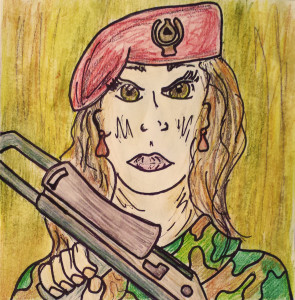
Correction: The author of this piece asked to have his/her name removed for personal reasons.
They carry guns, dress in jumpsuits and boast impeccable eyeliner — such is the irresistible image the US media has created for the female peshmerga soldiers of two influential Kurdish political parties. In southeastern Turkey and northwestern Syria, respectively, the Kurdistan Workers’ Party (PKK) and People’s Protection Units (YPG) have employed battalions of these fighters for many years, but their most recent claim to fame has been their fight against the Islamic State in Iraq and Syria (ISIS). Dozens of articles about these “badass women” fighting ISIS have flooded English-language media accompanied by objectifying, and ultimately damaging, images of beautiful women and their rifles. The apotheosis of these soldiers even rose to the point where H&M designed — and then was pushed to recall — a “peshmerga chic” khaki jumpsuit.
The newfangled focus on this decades-old group has appeared parallel to the founding of the US-led anti-ISIS coalition. By focusing on the role of female Kurdish fighters in the battle against ISIS, Western media sources inflate the assumption that the peshmerga, or pesh, are the perfect ally in a turbulent Middle East. But one snag makes the romanticization of these forces a lot more complicated: The PKK is listed as a terrorist organization on the State Department watch list. The female pesh are a stark example of the unconventional associates that the United States has had to rely on in a region largely hostile to the West. America’s Kurdish partners are not the great hope of the Middle East and can hardly be said to be fighting for Western-style democracy.
The PKK and YPG are two militant wings of the fractious Kurdish nationalist movement. The peshmerga — literally “those who face death” — earned their chops fighting for Mustafa Barzani’s Kurdish Regional Government in Northern Iraq during the ’60s and ’70s and in his son Masoud’s government during the Iran-Iraq War in the ’80s. Female pesh have only reappeared in the media in the past few months, with outlets busying themselves drawing an impermeable boundary between ISIS and the peshmerga. This largely centers on the narratives of how each group treats its women; female pesh are presented as embodiments of liberal democratic ideals in contrast to the arcane misogyny of ISIS. But the Kurdish communities from which the pesh come — where honor killings are still common — largely maintain traditional gender roles.
There is little question that the terrorist designations of the PKK and YPG are well-founded. The period of greatest PKK activity during the mid-’90s in Turkey was one of immense unrest and fear, with both the PKK and the government committing atrocities that contributed to a 45,000-person death toll. The PKK’s most notorious tactic is its use of female suicide bombers, including one infamous case in which a pregnant suicide bomber killed six Turkish soldiers in 1996. Additionally, the PKK and YPG have a fractured base: Not all Kurds support a physical fight for a sovereign, independent Kurdistan. This is especially true in Turkey, where the battle for greater civil rights and regional autonomy is taking place largely in Parliament and the courts. Yet the West seems to have reconsidered its position on these armed militias, a fact that analysts have claimed may be a reason why Turkey expressed reluctance to join the anti-ISIS coalition.
The US position is bolstered by Western media coverage of the female pesh that softens the public’s gaze on these violent guerillas. Conservative sources, including The Telegraph, have highlighted an oft-quoted but unfounded rumor that ISIS fighters “know their reward will come in heaven, in the shape of 72 virgins — but not apparently if they are killed by women.” The PKK and YPG have also been given the opportunity to reconcile the public perception of themselves abroad: “We have been called terrorists for years,” one female fighter told Foreign Policy in September, but ISIS “beheads civilians…We have rescued civilians.”
It is unclear whether the media’s love affair with the female pesh will make Western nations more supportive of Kurdish autonomy in the future. In the early ’90s, Masoud Barzani’s Iraqi Kurds fought on the side of the US-led international coalition against Saddam Hussein. Then, as now, CNN trained its cameras on the faces of Kurdish women, who were cast as empowered young ladies participating in a righteous war against a temperamental regional strongman. Yet just a decade later, faced with the necessity of currying favor with Turkey, the PKK was internationally castigated as a terror group. Former President George W. Bush described the PKK as “an enemy of Turkey, a free Iraq and the United States.” Now recent reports suggest that the EU and United States are considering lifting the PKK’s terrorist designation. In response, talking heads across Washington have affirmed that the Kurds are the West’s most “solid allies in the long-term war that jihadism has declared against us” and that the Kurds are “our best friends inside Syria.” In many ways, the media’s questionable use of the female peshmerga as a symbol of an allied cause is just the latest example in a long history of self-serving rhetoric.
The upsurge in media coverage of the female pesh helps repaint Middle Eastern battlefields as portraits of ideological struggle with far-reaching consequences rather than landscapes of sectarian violence. The West’s fairweather friendship with the Kurds is one of the only invariable features of Middle Eastern politics in the past four decades. America’s boldfaced political and sexual co-optation of the female rebels creates tacit support for their terrorism and undermines attempts to resolve the regional crisis.
